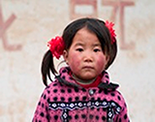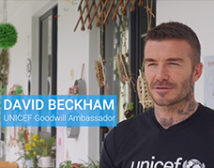LONDON, 19 January 2015 – Around 63 million adolescents between the ages of 12 to 15 years old are denied their right to an education, according to a new joint report from the UNESCO Institute for Statistics and UNICEF, Fixing the Broken Promise of Education for All: Findings from the Global Initiative on Out-of-School Children, released today during the Education World Forum.

©UNICEF Philippines/2014/Hema Balasundaram
Althea Jane, age 8, in class at Kapangian Central School in Tacloban City. The school was damaged by Typhoon Haiyan and received support from UNICEF in the form of school repairs, teaching and learning materials, and repairs and upgrades of handwashing facilities and toilets. |
Globally, 1 in 5 adolescents is not in school compared to 1 in 11 primary school-age children. So adolescents are twice as likely to be out of school as their younger counterparts. The report also shows that as children get older, the risk that they will never start school or will drop out increases.
In total, 121 million children and adolescents have either never started school or dropped out despite the international community's promise to achieve Education for All by 2015. Data show that there has been almost no progress in reducing this number since 2007. Children living in conflict, child labourers and those facing discrimination based on ethnicity, gender and disability are the most affected. There is also a growing concern that previous gains in expanding access to education will erode without a major shift in policies and resources.
“Business as usual strategies based on more teachers, more classrooms and more textbooks are not enough to reach the most disadvantaged children,” said UNESCO Director-General Irina Bokova. “We need targeted interventions to reach the families displaced by conflict, the girls forced to stay home, the children with disabilities and the millions obliged to work. But these policies come at a cost. This report serves as wake-up call to mobilise the resources needed to guarantee basic education for every child, once and for all.”
As pressure mounts to include universal secondary education in the post-2015 global development agenda, the report shows the way forward to break the barriers that keep children out of school. If current trends continue, 25 million children – 15 million girls and 10 million boys – are likely to never set foot inside a classroom.
The highest out-of-school rates are in Eritrea and Liberia, where 66 per cent and 59 per cent of children, respectively, do not go to primary school. In many countries, the rates of exclusion are even higher for older children, especially girls. In Pakistan, 58 per cent of adolescent girls roughly between the ages of 12 and 15 are out of school compared to 49 per cent of boys.
 ©UNICEF/BANA2014-01515/Kiron ©UNICEF/BANA2014-01515/Kiron
Tania Rowshan, Head Teacher at Choto Shimultala Government Primary School takes classes using supplementary reading materials for school children at Palashbari, Gaibandha on 23 June 2014. |
Poverty is the greatest barrier to education, according to the report. In Nigeria, two-thirds of children in the poorest households are not in school and almost 90 per cent of them will probably never enrol. In contrast, only 5 per cent of the richest children are out of school and most of them are expected to start in the future(see the interactive data tool).
UNESCO and UNICEF believe that new policies must focus specifically on the most marginalised children as part of larger efforts to improve access to and quality of education. To do this, governments need robust information on who these children are, where they live, whether they have ever attended school and if they are likely to do so in the future. But many of these children remain invisible within current data collection methods. Children with disabilities are amongst the least visible – reliable data simply don't exist – and they are being overlooked in national responses to out-of-school children.
The report calls for action to invest in better data and demonstrates that reaching the most marginalized may initially cost more but also yields greater benefits. Better statistics and innovative tools can help guide governments and donors to allocate their education funding more effectively and efficiently.
********
To receive a copy of the report under embargo or to organize interviews, contact Amy Otchet, a.otchet@unesco.org, cell: +1 514 402 7836
The Out-of-School Children Initiative
The Out-of-School Children Initiative– a partnership between UNICEF and the UNESCO Institute for Statistics – is working in more than 50 countries to identify which children are out of school, assess the barriers that exclude them and develop innovative policies to get them in classrooms and learning.
Explore the Data
See the interactive data tool to better understand which children are out of school and why at http://on.unesco.org/oosci-global.
About the UNESCO Institute for Statistics
The UNESCO Institute for Statistics has built the world's most comprehensive education database, which is the official source of data used to monitor progress towards Education for All and related targets of the Millennium Development Goals. Data for more than 200 countries are freely available at http://www.uis.unesco.org.
About UNICEF
UNICEF promotes the rights and wellbeing of every child, in everything we do. Together with our partners, we work in 190 countries and territories to translate that commitment into practical action, focusing special effort on reaching the most vulnerable and excluded children, to the benefit of all children, everywhere. For more information about UNICEF and its work visit: http://www.unicef.org.
Visit our official website: www.unicef.cn
Follow us: Sina Weibohttp://weibo.com/unicefchina Tecent Weibo http://t.qq.com/unicef
For further information, please contact: Shantha Bloemen, UNICEF China, +8610 85312610, sbloemen@unicef.orgor Liu Li, UNICEF China, +8610 85312612, liliu@unicef.org






























